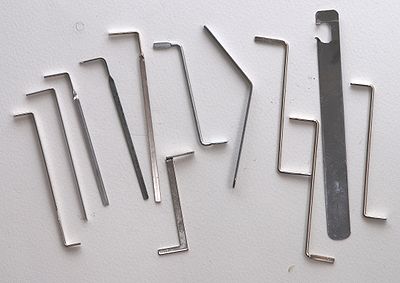Tension: Difference between revisions
No edit summary |
mNo edit summary |
||
| Line 3: | Line 3: | ||
[[Image:Tension_tools.jpg|thumb|400px|right|text-top|A variety of [[Pin_tumbler|pin-tumbler]] tension tools.]] | [[Image:Tension_tools.jpg|thumb|400px|right|text-top|A variety of [[Pin_tumbler|pin-tumbler]] tension tools.]] | ||
'''Tension''' (or '''torque''', '''torsion''') is a fundamental [[Lockpicking|lockpicking]] principle that allows a [[Lock|lock]] to be compromised by exploiting tolerance errors to defeat each locking component individually. A tool is used to apply tension to the lock while a [[Picks|pick]] properly | '''Tension''' (or '''torque''', '''torsion''') is a fundamental [[Lockpicking|lockpicking]] principle that allows a [[Lock|lock]] to be compromised by exploiting tolerance errors to defeat each locking component individually. A tool is used to apply tension to the lock while a [[Picks|pick]] properly position internal components. Once all components are positioned correctly the tension tool may be used to [[Actuator|actuate]] the locking [[Bolt|bolt]]. | ||
Tension tools are commonly referred to as tension bars, tension wrenches, or torque wrenches. Their design varies widely, but is most commonly associated with the L shaped [[Pin_tumbler|pin-tumbler]] tension tool. Like picking tools, most tension tools leave [[Forensics|forensic]] evidence in the lock. | Tension tools are commonly referred to as tension bars, tension wrenches, or torque wrenches. Their design varies widely, but is most commonly associated with the L shaped [[Pin_tumbler|pin-tumbler]] tension tool. Like picking tools, most tension tools leave [[Forensics|forensic]] evidence in the lock. | ||
Compromise of warded, electronic, and combination locks ususally does not require a tension tool, though a similar tool may be used to actuate the locking bolt. | |||
__TOC__ | __TOC__ | ||
== Tension Tools == | == Pin-tumbler/Wafer Tension Tools == | ||
In pin-tumbler, wafer, dimple, and axial locks, tension is applied to the [[Plug|plug]] of the lock. | |||
<!-- | <!-- | ||
L, short L, curved L, double sided L, thick/bent L, flat Z, falle, automatic round, automatic weighted, feather touch, auto prong, tulip | L, short L, curved L, double sided L, thick/bent L, flat Z, falle, automatic round, automatic weighted, feather touch, auto prong, tulip | ||
| Line 26: | Line 25: | ||
: | : | ||
--> | --> | ||
== Lever Tension Tools == | |||
In [[Lever|lever]] locks, tension is usually applied directly to the bolt, but may vary depending on the design of the lock. In most cases, tension tools resemble the tip of a lever key. | |||
== Disc-detainer Tension Tools == | |||
In [[Disc_detainer|disc-detainer]] locks, tension is applied to varying parts of the lock, depending on the specifics of the lock. | |||
== See also == | == See also == | ||
Revision as of 17:35, 25 March 2009
Tension

Tension (or torque, torsion) is a fundamental lockpicking principle that allows a lock to be compromised by exploiting tolerance errors to defeat each locking component individually. A tool is used to apply tension to the lock while a pick properly position internal components. Once all components are positioned correctly the tension tool may be used to actuate the locking bolt.
Tension tools are commonly referred to as tension bars, tension wrenches, or torque wrenches. Their design varies widely, but is most commonly associated with the L shaped pin-tumbler tension tool. Like picking tools, most tension tools leave forensic evidence in the lock.
Compromise of warded, electronic, and combination locks ususally does not require a tension tool, though a similar tool may be used to actuate the locking bolt.
Pin-tumbler/Wafer Tension Tools
In pin-tumbler, wafer, dimple, and axial locks, tension is applied to the plug of the lock.
Lever Tension Tools
In lever locks, tension is usually applied directly to the bolt, but may vary depending on the design of the lock. In most cases, tension tools resemble the tip of a lever key.
Disc-detainer Tension Tools
In disc-detainer locks, tension is applied to varying parts of the lock, depending on the specifics of the lock.